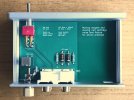beeface
Senior Member
- Joined
- Dec 5, 2017
- Messages
- 482
- Likes
- 1,139
I wonder when we'll see a product beat the Cambridge Solo on the SINAD chart?
I wouldn't get too wound up about the panther tbh, it's just a bit of fun
On that note, I just looked at Stereophile's recommended list out of curiosity. You have to scroll quite a bit before you find something in the three figure range
I don't see how this gets the same rating as the Mani 2. So far as I can see, we have higher headroom at 45, pretty close at 60, higher headroom at all frequencies, lower sinad by a hair overall. Yet, this is $799 vs $149 for which you get some useful features, for some people. But 90% won't care about balanced and will set and forget the settings so the bottom facing adjustments aren't as big an issue either)).
I wouldn't get too wound up about the panther tbh, it's just a bit of fun
On that note, I just looked at Stereophile's recommended list out of curiosity. You have to scroll quite a bit before you find something in the three figure range

 with positive bias perhaps? The effect will be much the same! In this case, the clipping will most likely be occurring in the first stage before RIAA equalisation. So intermodulation products from clipping at 20kHz due to surface defects are going to be boosted up by 20dB at 1kHz, and 33dB at 100Hz. These assymetrical artefacts (see how a click/pop waveform contains HF content in one direction) will create far more noticeable artefacts where we will actually hear them as a result...
with positive bias perhaps? The effect will be much the same! In this case, the clipping will most likely be occurring in the first stage before RIAA equalisation. So intermodulation products from clipping at 20kHz due to surface defects are going to be boosted up by 20dB at 1kHz, and 33dB at 100Hz. These assymetrical artefacts (see how a click/pop waveform contains HF content in one direction) will create far more noticeable artefacts where we will actually hear them as a result...